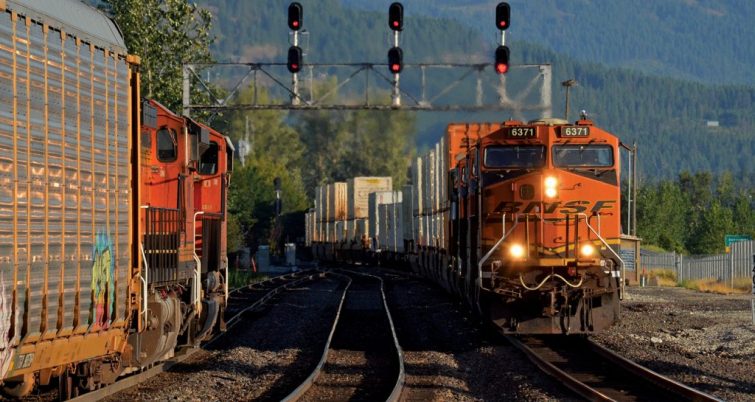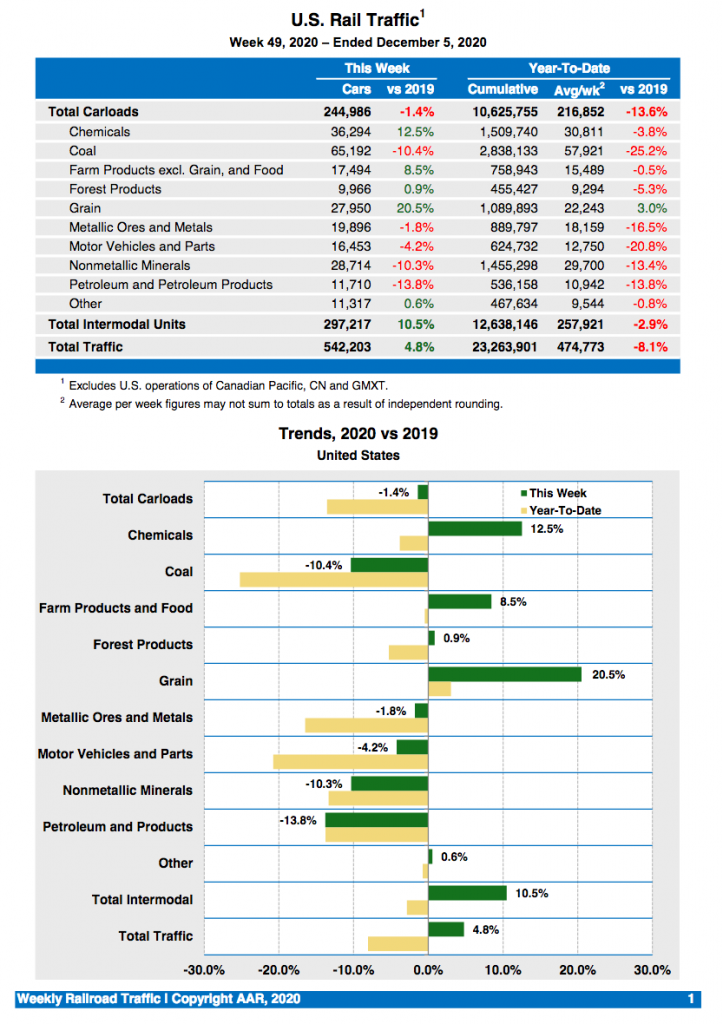Carloads essentially flat—intermodal up 10 percent
Written by David C. Lester, Editor-in-Chief
Editor’s Note: Rail traffic for the week ending Dec. 5, 2020 essentially repeated the same pattern we’ve seen in the past several weeks. Total carloads (carloads + intermodal) are up, carloads are slightly down, and intermodal posted a healthy increase.
We’re currently experiencing some of the highest numbers of cases, hospitalizations and deaths we’ve seen since the pandemic began. And, medical experts predict the high number of cases at the moment will get worse during the next couple of months. What impact will this have on the economy and rail traffic?
At this point, holiday sales are likely driving the majority of the intermodal increase, but will the worsening of the pandemic reduce holiday sales and, therefore, intermodal loadings? And, considering that consumers are advised to order early for the holidays, will sales start to sputter when we reach the week of Christmas? Just some questions to ponder going forward. Stay tuned. DCL
The Association of American Railroads (AAR) today reported U.S. rail traffic for the week ending December 5, 2020.
For this week, total U.S. weekly rail traffic was 542,203 carloads and intermodal units, up 4.8 percent compared with the same week last year.
Total carloads for the week ending December 5 were 244,986 carloads, down 1.4 percent compared with the same week in 2019, while U.S. weekly intermodal volume was 297,217 containers and trailers, up 10.5 percent compared to 2019.
Five of the 10 carload commodity groups posted an increase compared with the same week in 2019. They included grain, up 4,757 carloads, to 27,950; chemicals, up 4,043 carloads, to 36,294; and farm products excluding grain, and food, up 1,365 carloads, to 17,494. Commodity groups that posted decreases compared with the same week in 2019 included coal, down 7,535 carloads, to 65,192; nonmetallic minerals, down 3,304 carloads, to 28,714; and petroleum and petroleum products, down 1,871 carloads, to 11,710.
For the first 49 weeks of 2020, U.S. railroads reported cumulative volume of 10,625,755 carloads, down 13.6 percent from the same point last year; and 12,638,146 intermodal units, down 2.9 percent from last year. Total combined U.S. traffic for the first 49 weeks of 2020 was 23,263,901 carloads and intermodal units, a decrease of 8.1 percent compared to last year.
North American rail volume for the week ending December 5, 2020, on 12 reporting U.S., Canadian and Mexican railroads totaled 348,727 carloads, down 1.7 percent compared with the same week last year, and 387,098 intermodal units, up 9.2 percent compared with last year. Total combined weekly rail traffic in North America was 735,825 carloads and intermodal units, up 3.8 percent. North American rail volume for the first 49 weeks of 2020 was 32,022,836 carloads and intermodal units, down 7.4 percent compared with 2019.
Canadian railroads reported 83,831 carloads for the week, down 2.5 percent, and 75,310 intermodal units, up 12.2 percent compared with the same week in 2019. For the first 49 weeks of 2020, Canadian railroads reported cumulative rail traffic volume of 7,058,218 carloads, containers and trailers, down 4.7 percent.
Mexican railroads reported 19,910 carloads for the week, down 1.3 percent compared with the same week last year, and 14,571 intermodal units, down 21.1 percent. Cumulative volume on Mexican railroads for the first 49 weeks of 2020 was 1,700,717 carloads and intermodal containers and trailers, down 9.8 percent from the same point last year.






